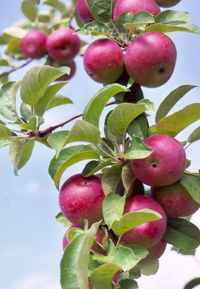Bulletin #2409, Renovating Old Apple Trees

Prepared by James R. Schupp, Extension Tree Fruit Specialist, University of Maine Cooperative Extension.
For information about UMaine Extension programs and resources, visit extension.umaine.edu.
Find more of our publications and books at extension.umaine.edu/publications/.
Renovating old, neglected apple trees is hard work! Before undertaking such a large task, stop and ask why you’re doing it. Reasons for renovating old trees include:
- To enhance their appearance in the landscape.
- To restore an old tree with sentimental value.
- To get better quality fruit.
If the last reason is your only goal, you should reconsider whether you want to renovate or replant. It will take about three years to complete the renovation process and, in that amount of time, you could easily be harvesting fruit from a healthy, young, semi-dwarf tree.
Let’s assume you want to keep the old tree for personal reasons. The first step is to clear away any competing trees and brush. Apple trees don’t like shade. Then consider the shade the tree casts upon itself. Neglected trees become overgrown to the point where the center of the tree is shaded out. Pruning opens the canopy up. Old trees often produce too many small, poor quality fruit. Pruning removes many competing fruit buds and will boost fruit size and quality.
Pruning Strategies
Prune out any dead or diseased limbs. Then begin to remove competing branches that cross or crowd one another. Remove branches that go straight up or hang down. Branches that have a slight upward angle (rather than horizontal) are the best to leave. When you’re finished, the canopy should appear thinned out, with no dense clusters of branches anywhere in the canopy.
The following tips will help you do a good job of pruning.
- Do the pruning while the tree is dormant. It is best to wait until March or April, when the threat of severe cold weather is over, but finish the job before the tree begins to grow.
- Match the size of the tools to the task. It is usually easier and better to make a few large cuts than to make many small cuts.
- Follow the rule of thirds. Remove about a third of the excess limbs each year for three years.
It took the tree more than one year to become overgrown. It will take more than one year to correct. - Start in the top. This is where the pruning will do the most good. Prune progressively less as you move down in the canopy.
- Remove entire limbs and branches. Do not leave partial limbs or stubs. Thinning out entire limbs will result in considerably less regrowth.
Fertilizing Your Trees
Fertilizer is less important than pruning when it comes to revitalizing old apple trees. Get the soil tested to determine the need for lime, potassium (K) and magnesium (Mg). Your UMaine Extension County Office can provide soil test instructions and order forms, or contact the Analytical Lab and Maine Soil Testing Service, call 207.581.3591.
Nitrogen (N) is the one nutrient that you should apply with caution. Renovation pruning is usually quite severe, and if too much nitrogen is provided, the vegetative regrowth can be excessive. Unless the old tree is nearly dead, withhold N during renovation.
Once the severe pruning is finished, use the 12- to 18-inch rule for shoot growth. If there is less than 12 inches of shoot growth, increase the fertilizer; 12 to 18 inches, apply the same amount as last year; more than 18 inches, do not apply any nitrogen. Typical nitrogen applications for standard-sized trees would range from 0.5 to 1 pound of actual nitrogen per tree per year. If nitrogen was applied during renovation, halve these amounts.
For more information on apple trees, contact your UMaine Extension County Office.
Information in this publication is provided purely for educational purposes. No responsibility is assumed for any problems associated with the use of products or services mentioned. No endorsement of products or companies is intended, nor is criticism of unnamed products or companies implied.
© 2002
Call 800.287.0274 (in Maine), or 207.581.3188, for information on publications and program offerings from University of Maine Cooperative Extension, or visit extension.umaine.edu.
In complying with the letter and spirit of applicable laws and pursuing its own goals of diversity, the University of Maine System does not discriminate on the grounds of race, color, religion, sex, sexual orientation, transgender status, gender, gender identity or expression, ethnicity, national origin, citizenship status, familial status, ancestry, age, disability physical or mental, genetic information, or veterans or military status in employment, education, and all other programs and activities. The University provides reasonable accommodations to qualified individuals with disabilities upon request. The following person has been designated to handle inquiries regarding non-discrimination policies: Director of Institutional Equity and Title IX Services, 5713 Chadbourne Hall, Room 412, University of Maine, Orono, ME 04469-5713, 207.581.1226, TTY 711 (Maine Relay System).

